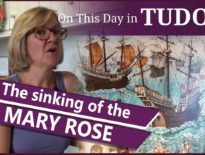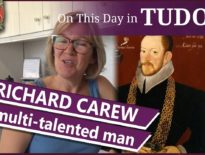On this day in Tudor history, 18th July 1553, while her father-in-law and his forces made their way from Cambridge to Bury St Edmunds to stand against the forces of Mary, and Jane was busy writing to men requesting them to muster forces to support her, Jane was being betrayed by members of her council.
William Herbert, Earl of Pembroke, and Henry Fitzalan, Earl of Arundel, called a council meeting and Pembroke was even said to have threatened council members with a sword! They then proclaimed for Mary.
Find out more about what happened on 18th and 19th July 1553 in today's talk.
Also on this day in Tudor history, 18th July 1509, just three months into the reign of King Henry VIII, one of King Henry VII's chief advisors was accused of being a "false traitor" and convicted of treason. The new king used Edmund Dudley and his colleague, Richard Empson, as scapegoats for his father's unpopular regime. Find out more about the charges against Dudley in last year’s video:
Also on this day in history:
- 1530 – Death of William Bonde, author and Bridgettine monk, at Syon Abbey. Bonde wrote two religious works, “The Pylgrimage of Perfection” (1526) and “The Directory of Conscience” (1527). He was buried at Syon Abbey and bequeathed twenty-nine works to the Abbey's library.
- 1536 – Burial of Desiderius Erasmus in Basel Cathedral.
- 1565 – Death of Katherine Ashley (née Champernowne), also known as Astley, in London. Kat was Chief Gentlewoman of the Privy Chamber during the reign of Elizabeth I, and had served as Elizabeth's governess during the latter's teenage years.
Transcript:
On this day in Tudor history, 18th July 1553, while John Dudley, Duke of Northumberland, and his forces made their way from Cambridge to Bury St Edmunds to stand against the forces of Mary, half-sister of the late king, Edward VI, back in London, William Herbert, Earl of Pembroke, and Henry Fitzalan, Earl of Arundel, called a council meeting.
These two councillors had been uneasy about the accession of Queen Jane, in place of Mary, and by this point had heard reports of Mary being proclaimed queen in different towns and cities, and of the size of her army. They did not want to be on the losing side.
So, Pembroke and Arundel took action. They called a council meeting at Baynard’s Castle, Pembroke’s property, and there, they betrayed Northumberland and Queen Jane. They persuaded many council members that Mary's claim to the throne was legitimate.
In “The Lives of the Lord Chancellors and Keepers of the Great Seal of England” (1848), John, Lord Campbell, writes of the Earl of Pembroke's persuasion techniques:
“The Earl of Pembroke then drew his sword, exclaiming, ‘If the arguments of my Lord of Arundel do not persuade you, this sword shall make Mary queen, or I will die in her quarrel.’”
The following day, 19th July 1553, Sir John Mason and the Earl of Shrewsbury, brought the Lord Mayor of London to Baynard’s Castle, where he was informed of the council’s change of heart. Mason and Shrewsbury also visited the imperial ambassadors to inform them that the majority of the council “had been persuaded that the Lady Mary was rightful queen, and had decided to proclaim her as such this very day”. On that very day, Mary was officially proclaimed queen in London. Te deums were sung, bells rang throughout the night, bonfires were lit in the streets, bells rang in every parish church where the news reached, and there was apparently “good cheer”.
And what of Jane?
Well, while members of her council were busy betraying her, she was busy writing letters as Jane, the Queen. The first was to Sir John St Lowe and Sir Anthony Kingston, ordering them to muster forces and to “repair with all possible speed towards Buckinghamshire for the repressing and subduing of certain tumults and rebellions moved there against us and our Crown by certain seditious men”. The second letter was to Sir John Brydges and Sir Nicholas Poyntz ordering them to do the same. She was completely unaware of Pembroke and Arundel’s betrayal, referring to them in her letter as “our Right Trusty and Right Well Beloved Cousins”.
In the Tower of London, on the evening of 19th July 1553, the day after these right well beloved cousins had turned her council against her, Jane’s father, Henry Grey, Duke of Suffolk, ripped down the cloth of estate and told Jane that she was no longer queen. Her reign was over, Mary was queen.



Leave a Reply